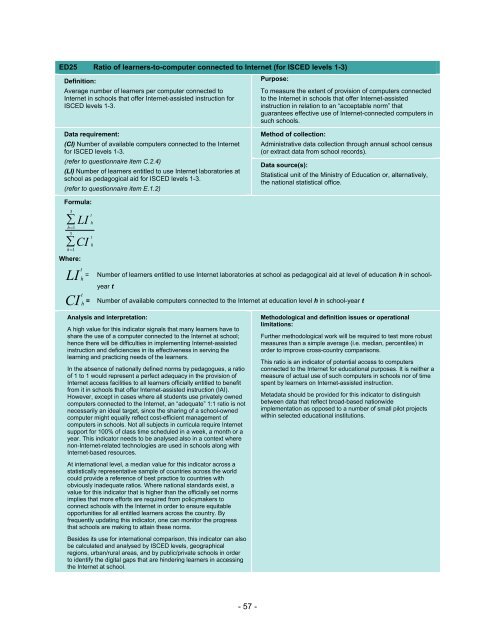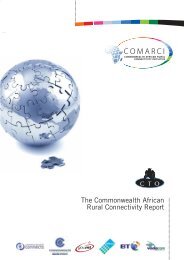Guide to measuring information and ... - unesdoc - Unesco
Guide to measuring information and ... - unesdoc - Unesco
Guide to measuring information and ... - unesdoc - Unesco
You also want an ePaper? Increase the reach of your titles
YUMPU automatically turns print PDFs into web optimized ePapers that Google loves.
ED25 Ratio of learners-<strong>to</strong>-computer connected <strong>to</strong> Internet (for ISCED levels 1-3)<br />
Definition:<br />
Average number of learners per computer connected <strong>to</strong><br />
Internet in schools that offer Internet-assisted instruction for<br />
ISCED levels 1-3.<br />
Data requirement:<br />
(CI) Number of available computers connected <strong>to</strong> the Internet<br />
for ISCED levels 1-3.<br />
(refer <strong>to</strong> questionnaire item C.2.4)<br />
(LI) Number of learners entitled <strong>to</strong> use Internet labora<strong>to</strong>ries at<br />
school as pedagogical aid for ISCED levels 1-3.<br />
(refer <strong>to</strong> questionnaire item E.1.2)<br />
Formula:<br />
3<br />
LI<br />
h1<br />
3<br />
CI<br />
h1<br />
t<br />
h<br />
t<br />
h<br />
- 57 -<br />
Purpose:<br />
To measure the extent of provision of computers connected<br />
<strong>to</strong> the Internet in schools that offer Internet-assisted<br />
instruction in relation <strong>to</strong> an “acceptable norm” that<br />
guarantees effective use of Internet-connected computers in<br />
such schools.<br />
Method of collection:<br />
Administrative data collection through annual school census<br />
(or extract data from school records).<br />
Data source(s):<br />
Statistical unit of the Ministry of Education or, alternatively,<br />
the national statistical office.<br />
Where:<br />
LI t<br />
= Number of learners entitled <strong>to</strong> use Internet labora<strong>to</strong>ries at school as pedagogical aid at level of education h in school-<br />
h<br />
year t<br />
CI t<br />
h = Number of available computers connected <strong>to</strong> the Internet at education level h in school-year t<br />
Analysis <strong>and</strong> interpretation:<br />
A high value for this indica<strong>to</strong>r signals that many learners have <strong>to</strong><br />
share the use of a computer connected <strong>to</strong> the Internet at school;<br />
hence there will be difficulties in implementing Internet-assisted<br />
instruction <strong>and</strong> deficiencies in its effectiveness in serving the<br />
learning <strong>and</strong> practicing needs of the learners.<br />
In the absence of nationally defined norms by pedagogues, a ratio<br />
of 1 <strong>to</strong> 1 would represent a perfect adequacy in the provision of<br />
Internet access facilities <strong>to</strong> all learners officially entitled <strong>to</strong> benefit<br />
from it in schools that offer Internet-assisted instruction (IAI).<br />
However, except in cases where all students use privately owned<br />
computers connected <strong>to</strong> the Internet, an “adequate” 1:1 ratio is not<br />
necessarily an ideal target, since the sharing of a school-owned<br />
computer might equally reflect cost-efficient management of<br />
computers in schools. Not all subjects in curricula require Internet<br />
support for 100% of class time scheduled in a week, a month or a<br />
year. This indica<strong>to</strong>r needs <strong>to</strong> be analysed also in a context where<br />
non-Internet-related technologies are used in schools along with<br />
Internet-based resources.<br />
At international level, a median value for this indica<strong>to</strong>r across a<br />
statistically representative sample of countries across the world<br />
could provide a reference of best practice <strong>to</strong> countries with<br />
obviously inadequate ratios. Where national st<strong>and</strong>ards exist, a<br />
value for this indica<strong>to</strong>r that is higher than the officially set norms<br />
implies that more efforts are required from policymakers <strong>to</strong><br />
connect schools with the Internet in order <strong>to</strong> ensure equitable<br />
opportunities for all entitled learners across the country. By<br />
frequently updating this indica<strong>to</strong>r, one can moni<strong>to</strong>r the progress<br />
that schools are making <strong>to</strong> attain these norms.<br />
Besides its use for international comparison, this indica<strong>to</strong>r can also<br />
be calculated <strong>and</strong> analysed by ISCED levels, geographical<br />
regions, urban/rural areas, <strong>and</strong> by public/private schools in order<br />
<strong>to</strong> identify the digital gaps that are hindering learners in accessing<br />
the Internet at school.<br />
Methodological <strong>and</strong> definition issues or operational<br />
limitations:<br />
Further methodological work will be required <strong>to</strong> test more robust<br />
measures than a simple average (i.e. median, percentiles) in<br />
order <strong>to</strong> improve cross-country comparisons.<br />
This ratio is an indica<strong>to</strong>r of potential access <strong>to</strong> computers<br />
connected <strong>to</strong> the Internet for educational purposes. It is neither a<br />
measure of actual use of such computers in schools nor of time<br />
spent by learners on Internet-assisted instruction.<br />
Metadata should be provided for this indica<strong>to</strong>r <strong>to</strong> distinguish<br />
between data that reflect broad-based nationwide<br />
implementation as opposed <strong>to</strong> a number of small pilot projects<br />
within selected educational institutions.
















